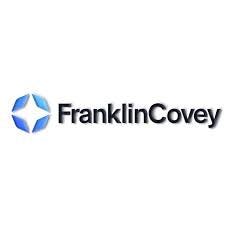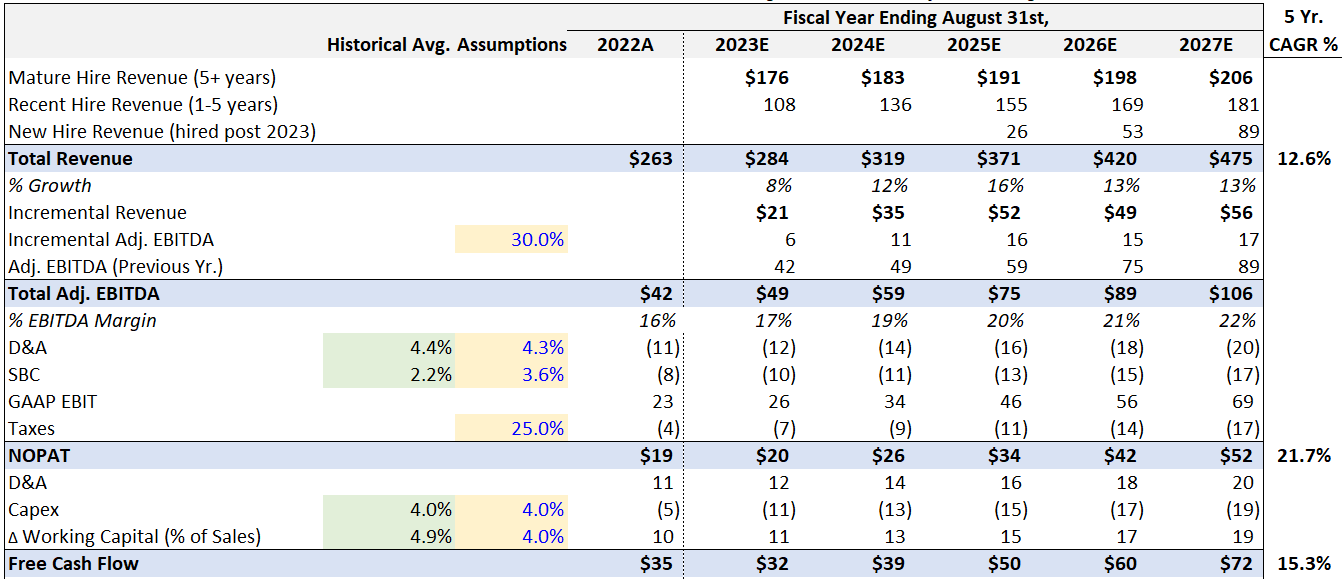Franklin Covey (FC)
Franklin Covey’s digital transformation has turned the leadership trainer into a software-like asset, yet the stock continues to trade at a cyclical, low margin valuation
Situation Overview
Franklin Covey’s digital transformation has turned the leadership trainer into a software-like asset, yet the stock continues to trade at a cyclical, low margin valuation. With 90%+ retention rates, 5% annual price increases, and a proven ability to upsell, FC is well positioned to grow subscription revenues without having to acquire many new customers. Combine that with the green salesforce (half of which was hired within the last 5 years), and FC should be able to clear 10% topline growth solely due to the maturation of the newly hired salespeople. If you layer in 5-6% headcount growth on top of that (below historical rates and half of what management is guiding) then topline growth should clear ~13% annualized, with operating leverage and stock buybacks bringing FCF / share growth to ~18%. This significantly exceeds the expectations implied by the current price (16.9x EV / CY22 FCF) providing the opportunity for total shareholder returns of ~20% annualized before any potential multiple expansion. This opportunity likely exists due to FC’s small size (~$600M market cap / $2.5-3mm shares traded daily), limited analyst coverage (4 secondary brokers), and a shift in revenue recognition policy that has masked the Company’s high growth to date.
Company Background
In 1989 Stephen Covey authored “The Seven Habits of Highly Effective People” which went on to sell ~40M copies in 50 languages. Not only does the popularity of this book make FC one of the most credible names in the leadership & development (L&D) industry, but the Seven Habits provided a foundation that all the latter books are based on. Following the 7 Habits, FC curated 20+ additional titles, providing the Company with ample content to start its corporate training business. FC broadly falls under the “leadership training” bucket, but its courses span across multiple categories including personal accountability, unconscious bias training, inclusive leadership, time management and execution of strategic goals. Leadership training is an attractive niche to play in given that 1) the problems that FC addresses are universal, enabling FC to deploy the software model of “build once and sell to many” 2) its content has a much longer shelf life than other media companies like Netflix, creating a capital light model that is less susceptible to changes in customer taste and 3) customers often end up integrating leadership training into their hiring, onboarding, and promotion processes, setting FC up for recurring, multi-year engagements.
In 2016 FC launched the All Access Pass (AAP), an online on demand offering that removed the need to pay live instructors. This boosted gross margins from ~66% to ~77% and made the incremental cost of distributing each course zero. This allowed FC to give AAP customers access to its entire portfolio of courses for just $215 annually per seat, which was the same price for a single course under the prior model. This quickly made the AAP the highest “bang for your buck” offering in the industry. Primary research confirms this with the L&D Head at Holiday Inn describing the AAP as being “by far the best value”. Similarly, Waste Management’s L&D Head explained that “all of them are good, but FC is who’s really been impressive… the ROI is fantastic… for your $200 you get access to numerous courses, whereas at the other trainers, you may pay more than $200 for only a single course.”
Competitive Position
While the overall L&D industry is fragmented, ~5 main competitors compete for the 300-2000+ employee organizations that FC focuses on: DDI, Crucial Conversations, Ken Blanchard, Center for Leadership Studies, and the Center for Executive Leadership. Given the popularity of the “all you can eat” model and the need for digital offerings post-COVID, these competitors have finally responded by launching passes of their own. However, even as competitors try to replicate Covey’s model, the Company’s lead in content, technology, and people will make it difficult to catch up. For example, competitors like Crucial Conversations only have 3-4 courses in their portfolio making it poorly positioned to launch an “all you can eat” pass. Going forward Covey’s content lead should only grow as they invest ~5% of sales annually on their course offerings. FC is similarly ahead in its tech offering. Given that most competitors didn’t start investing in tech until 2021, FC’s digital launch in 2016 gave the Company over 5 years of lead time. Covey built on this advantage by investing ~$10M to acquire an EdTech platform called Strive, substantially improving their user experience. Finally, FC has carefully constructed a dedicated service team that proactively addresses client sticking points, helping to drive high usage and renewal rates. Once inside the organization, FC’s implementation team is effective at driving AAP seat expansions and sales of add-on offerings. As a result, customers typically increase their spend substantially upon renewal, resulting in an average annual customer spend of $80K (nearly twice what customers typically spend in their first year).
Opportunity to Gain Share
Direct competitor benchmarking provides a helpful lens to assess the ROI of the AAP. However, direct competition typically isn’t the first or second most common cause of failing to close a sale. This is likely attributable to the leadership trainers low penetration rate in the overall L&D budget. Said another way, Covey’s ability to grow moving forward will be impacted more by its ability to attract dollars that were previously spent on alternatives than it will be by its ability to take business from the other 5 leadership trainers. For example, of the ~$100B spent annually in the U.S. on L&D, $8B is spent on outsourced training. Of that $8B, only ~$1.5-2B of that spend is currently being allocated to the main leadership trainers. Given that digitalization has significantly increased the customer value of the AAP, FC has the opportunity not just to take share from direct competitors, but also to start chipping away at the $8B that is being allocated to other types of outsourced training.
FC also has an opportunity to eat into the $90B that is currently being spent on internally generated content. While in-house course development allows corporations to tailor their courses to their distinct culture, this is an expensive luxury given that the problems that FC’s courses address are universal across firms. The industry rule of thumb is that it costs $15K-$50K for each hour of finished content (which requires both payroll and design software costs). Using this estimate, the reproduction cost of just one of the courses in FC’s portfolio would likely exceed $500K (assuming 20 hours of content per course at a cost of $25K per hour). For this same cost, a corporation could instead buy 500 annual passes from FC for five years, giving them access to not just one, but over 10 courses. When you consider the additional maintenance costs to refresh the courses (for context FC spends $15M+ annually on content refresh) the opportunity for corporations to outsource more of their training becomes increasingly attractive.
FC is also one of the only trainers that’s been able to convince the C-suite to buy training for their employees, with this making up one third of the Company’s sales. By demonstrating Peter Drucker’s thesis that “culture eats strategy for breakfast”, FC can help their customers execute on their strategic goals without racking up the billable hours with McKinsey. For example, research shows that ~57% of employees leave their jobs because of their boss, and the replacement cost for these employees is ~2x the cost of that employee’s salary. Therefore if the annual investment of ~$215 per user (who are often mid-level managers) results in even a modest improvement in manager performance, the increase in team retention and effectiveness would easily cover the subscription cost.
Growth Equation
The ramping of sales per existing salesperson is the key lever behind FC’s growth. Based on historical trends, each entry salesperson generates ~$350K in sales in their first year before ramping this up to ~$1.5M+ by year 5. If over 15 years of sales ramping trends repeat, then the group of ~140 salespeople (roughly half the salesforce) that were hired over the last 5 years should grow their sales by a weighted average of 20% annually. Similarly, assuming that each year FC is able to continues to raise prices by 5%, have 5% volume growth, and keep salespeople attrition below 6%, then the remaining ~160 salespeople that were hired 5+ years ago should also continue to ramp their sales at a rate of 10% annually.
It may be helpful to think of each of these 3 components as if FC was a retailer: the increase in salesforce headcount is equivalent to opening new stores, the fast ramp experienced by those with 1-5 years on the desk is equivalent to a recently opened store that is quickly reaching mature sales, and the slower but positive ramp of those hired more than 5 years ago is like a store that continues to see moderate same store sales growth even after reaching mature sales. Even if you assume zero net hires (or in other words that they only offset ~6% annual attrition rate primarily due to retirement), FC should still be able to achieve ~10% topline growth. The CEO corroborated this conclusion back on a 2012 earnings call when he stated: “And so I think if you add up and say you have got $55 million to $60 million growing at 5% (i.e. legacy salespeople of more than 5 years), and losing a little bit of that each year from retirement, you're growing this other very rapidly for the people who are in ramp (i.e. the salespeople hired less than 5 years ago), then the new salespeople each class starts its own ramp (i.e. the increase in headcount from new hires). You don't have to hire very many people to keep -- to hit your 10% growth goal.”
In reality, management is likely to expand the salesforce at least moderately, and I model 20 net hires in 2024 (representing a 5-6% annual headcount increase). Leading up to the launch of the AAP Covey grew headcount by 15% annually, however this has slowed down to ~7% since 2016. With the launch complete, FC appears ready to resume hiring as management has increased the recruiter headcount from 2 to 6, built out the back-end sales support team, reworked the salesperson manager structure, and improved the new hire sales training program.
Capital Allocation
For a business with nearly 80% gross margins, FC’s current EBITDA margin of ~10% is underwhelming. However, given that nearly one third of the Company’s SG&A is fixed, FC’s margins should increase substantially as the topline grows, with EBIT margins approaching 14% by 2017. Said another way, ~30% of incremental revenues should flow through as incremental EBITDA.
Importantly, history shows that FC will be able to achieve this growth while producing substantial amounts of FCF. For example, despite growing adjusted EBITDA from $27M in 2016 to $42M by 2022, the amount of invested capital tied up into the business decreased from $123M to $43M over the same time period. In other words, as opposed to burning cash in order to grow, FC is one of the rare companies that is able to generate cash as a result of growth. With Robert Whitman as Chairman (former PE investor and CEO from 2000-2021) FC will likely use a large portion of FCF to buy back stock. Recently FC took out a new revolver with buyback friendly covenants, allowing the Company to take out 6% of shares outstanding last quarter alone. Going forward I model 40% of CFO being spent on repurchases (below historical levels of ~65% since 2016), resulting in shares outstanding decreasing from 13.9M to 10.8M over the next 4.5 years.







Hey Kyle interesting idea. When you refer to 90%+ retention rates, is that gross customer or net dollar?